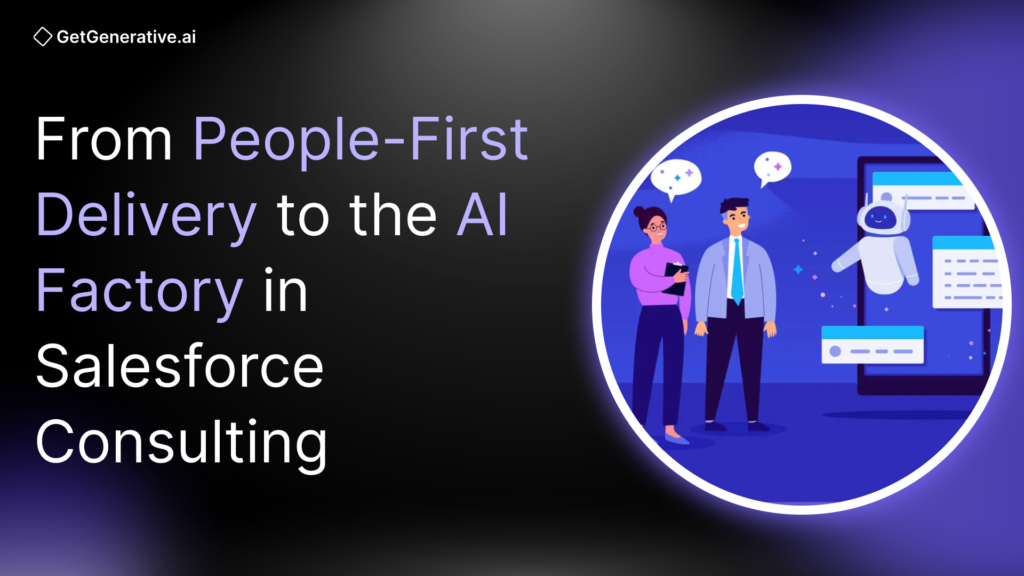From People-First Delivery to the AI Factory in Salesforce Consulting
Salesforce implementations have historically relied on large teams of experts—architects, developers, analysts, testers—delivering results through sheer human effort.
But in today’s AI-driven world, this “people-first” delivery model is reaching a breaking point. With the rise of generative AI, businesses are under pressure to accelerate timelines, reduce costs, and deliver higher-quality CRM solutions faster than ever before.
So, what if we reimagined Salesforce delivery using lean pods of people augmented by intelligent AI agents?
This blog explores how the AI Factory model is revolutionizing Salesforce consulting.
The Traditional Salesforce Delivery Model: Where It Excels and Where It Breaks
For decades, Salesforce projects have been delivered through large, people-heavy teams aligned to a waterfall or phased methodology. Every role—business analysts, architects, developers, testers—plays a crucial part, especially in complex enterprise implementations.
This model made sense when automation was limited, and human labor was the only path to custom code, configuration, data migration, and end-user training.
But this model is under strain. Why?
- Scale and Complexity: Salesforce Data Cloud exceeded 50 trillion records in 2025, doubling year-over-year. This sheer scale adds pressure on teams to build, customize, and integrate faster than ever.
- Customization Overload: Each new feature—be it a custom object or API integration—requires code, configuration, and QA, lengthening timelines and inflating costs.
- Linear Execution: Traditional project phases—design → build → test → deploy—mean teams operate in sequence, not in parallel.
- Inefficient Coordination: Larger teams require more communication and hand-offs, often leading to delays and misunderstandings.
Let’s take a closer look at the four major pain points facing the legacy model:
1. Data Migration and Integration Overhead
Moving data from legacy systems and integrating multiple platforms is a massive, manual task. Without automation, teams spend weeks on data cleansing, mapping, and validation, which drives up costs and delays ROI.
2. Testing Bottlenecks
Manual testing can inflate QA budgets and introduce risk. Even with large QA teams, edge cases often go untested. The cost of human testing has become a key bottleneck for many Salesforce projects.
3. Training and Adoption Challenges
People-first change management is time-consuming and inconsistent. In-person training, manuals, and post-launch support are expensive and often ineffective, leading to poor adoption.
4. Coordination and Communication Lag
Every additional person on a team introduces complexity. As Fred Brooks famously noted in The Mythical Man-Month, adding people to a late project only makes it later.
“The old model is reaching a point of diminishing returns, just as businesses are seeking faster, more agile implementation methods.”
The Gap Between the Traditional Model and an AI-Native Future
Can AI simply be “added” to the traditional consulting workflow? Not quite.
The problem isn’t just about plugging AI into legacy workflows—it’s a structural mismatch between how humans work and how AI operates best. Traditional delivery is bespoke, sequential, and siloed. AI thrives on repeatability, automation, and parallelism.
Key Mismatches
Legacy Model | AI-Native Model |
Linear phases | Continuous iteration |
Custom, project-by-project | Reuse across clients and use cases |
High human effort | High automation, low overhead |
Role-based execution | AI agent-based orchestration |
Most firms still treat AI as a nice-to-have. But early adopters recognize that generative AI can 10x delivery speed and improve project outcomes—if embedded properly.
Also Read – Service-as-Software: The convergence of Software and Services
Reimagining the Delivery Model: Pods of People + AI Agents
Pod-based delivery model—small expert teams (2–5 people) paired with domain-specific AI agents that automate 80% of the repetitive tasks.
What does a Pod Look Like?
- Salesforce Architect: Oversees solution integrity
- Business Analyst: Refines requirements and validates outputs
- AI Agents:
- Design Agent: Generates user stories, solution designs
- Code Agent: Writes Apex, LWC, and configurations
- Testing Agent: Generates and runs test cases
- Support Agent: Automates post-deployment ticket resolution
Think of it like an AI assembly line, with human experts supervising the output and AI agents doing the repetitive work at lightning speed.
“In the time a traditional team produces one MVP, an AI Factory-enabled team might deliver multiple tested releases.”
Real-World Impact
- Speed: Salesforce reports that ~20% of its internal code is already written by AI. AI-generated designs, stories, and test cases compress delivery time by 50–80%.
- Cost: AI-native teams can reduce delivery costs by 30–50% by eliminating human grunt work.
- Quality: AI-driven outputs follow rules and patterns without fatigue, enhancing consistency and reducing errors.
Introducing the AI Factory Model
The AI Factory isn’t just a metaphor—it’s a systematic, repeatable operating model where AI is embedded into every phase of Salesforce consulting.
Core Principles of the AI Factory
- Standardized Pipelines – From proposal to deployment, every step uses AI-driven patterns
- Repeatability at Scale – Templates, models, and agents are reused across projects
- Lean, Cross-Functional Pods – Agile teams with embedded AI “co-workers”
- Outcomes over Effort – Value delivered is measured in business impact, not billable hours
A Look at the Assembly Line
Stage | AI Agent Involved |
Pre-Sales | Pre-Sales Agent (proposal generation, estimation) |
Design | Design Agent (solution diagrams, user stories) |
Build | Code Agent (Apex/LWC generation) |
Test | Testing Agent (test cases, execution) |
Deploy & Support | Deploy Agent, Support Agent (config fixes, ticket resolution) |
Firms like Deloitte and IBM are already building their own AI Factory frameworks.
For Salesforce consulting, GetGenerative.ai is leading the charge with purpose-built agents that handle each stage of the implementation lifecycle.
Building the AI-Powered Delivery Team: New Roles, New Capabilities
Transitioning to the AI Factory model means more than plugging in tools—it requires redefining roles and upskilling talent. While traditional Salesforce projects relied heavily on task-based human execution, AI-native models shift humans into strategic, supervisory, and orchestration roles.
Key Roles in an AI-Enhanced Pod
AI Delivery Manager (Pod Leader)
- Aligns AI capabilities with business goals
- Prioritizes use cases and oversees agent outputs
- Acts as the factory floor supervisor, ensuring consistent, high-quality throughput
AI-Augmented Business Analyst
- Structures inputs for AI agents (e.g., workshops → user stories)
- Reviews and refines AI-generated documentation and designs
- Bridges client intent with AI outputs
Prompt Engineer / AI Architect
- Crafts precision prompts to steer AI agents
- Designs AI flows to generate architecture, code, or test cases
- Emerging as one of the most in-demand roles in generative AI consulting
AI Platform Engineer / Model Mechanic
- Tunes AI models for Salesforce-specific terminology
- Integrates agents with Salesforce APIs and enterprise systems
- Ensures models are scalable, compliant, and domain-aware
Data Engineer & Data Scientist
- Prepares data pipelines for training and grounding AI agents
- Creates embeddings, vector databases, and knowledge repositories
- Evaluates agent performance using metrics like coverage, accuracy, and velocity
AI-Enhanced Developers and Consultants
- Prompt AI code generators, then review/refactor outputs
- Use config agents to auto-generate Flows or schema mappings
- Shift from manual execution to orchestration and validation
“AI-enhanced developers aren’t replaced—they’re elevated. They work smarter, not harder, delivering more value with less effort.”
By staffing pods with a few of these hybrid roles, a single team can achieve 10x throughput compared to traditional setups.
GetGenerative.ai: Your AI Assembly Line for Salesforce Projects
GetGenerative.ai is one of the few platforms purpose-built to operationalize this AI Factory vision for Salesforce.
Full Lifecycle Agent Suite:
Agent | Function |
Pre-Sales Agent | Creates proposals, estimates, and solution design slides |
Design Agent | Generates user stories, acceptance criteria, ERDs |
Build Agent | Builds configuration tasks, LLDs, and execution plans |
Code Agent | Writes Apex code, LWC, Triggers, and SOQL from user stories |
Test Agent | Generates test cases, executes them, logs defects |
Support Agent | Suggests fixes for support tickets, syncs changes to documentation |
Real-World Impact
- Up to 80% reduction in proposal writing time
- 50–70% savings in design and documentation efforts
- 50%+ reduction in Apex/LWC coding time
- Automated test case coverage across 15+ QA types
GetGenerative integrates with Salesforce, Jira, GitHub, and more, enabling real-time collaboration and traceability. It provides a secure, private, enterprise-grade environment aligned with compliance best practices.
“With GetGenerative.ai, consulting firms don’t need to build an AI Factory from scratch—they can deploy a plug-and-play digital workforce.”
Transforming Processes: From Waterfall to Assembly Line
To unlock the true power of AI, firms must evolve their processes:
- Automate hand-offs between phases via AI pipelines
- Introduce AI checkpoints (e.g., Design Review for AI-generated LLDs)
- Shift from phase-based to continuous delivery, enabled by agent speed
- Document learnings and reuse: AI-generated assets (like a great CPQ configuration prompt) should be stored and reused across projects
Modern firms are now designing entire project lifecycles around AI velocity, not just human capacity. Internal KPIs are shifting from “hours billed” to “business outcomes delivered.”
Also Read – From SaaS to AI: Overcoming Data and Security Fears in the AI Era
Best Practices for Adopting the AI Factory Model
Start Small: Pilot a Pod
Choose a well-defined project. Use 2–3 AI agents. Show ROI in 30–90 days. Build internal excitement.
Redesign Processes
Rethink your delivery workflow. Where can AI replace repetition? Where does it need human oversight? Codify this.
Upskill Continuously
Train your staff in prompt engineering, AI supervision, and design review. Celebrate wins and AI successes.
Govern Responsibly
Implement Responsible AI frameworks. Monitor for bias. Enforce ethical guardrails. Secure sensitive inputs.
Track & Evangelize Results
Measure time saved, quality improved, and cost reduced. Share stories internally and with clients to build trust.
The Strategic Advantage
In an increasingly competitive consulting market, AI-native delivery can be your core differentiator:
- Win More Deals: Offer fixed-price, fast-track delivery packages
- Expand Margins: Do more with fewer people
- Attract Talent: Top talent wants to work with cutting-edge AI tooling
- Earn Trust: Clients ask: How will you use AI to save us time and money?
The AI Factory approach helps you answer confidently and deliver convincingly.
Final Thoughts
The AI Factory isn’t science fiction—it’s Salesforce Consulting’s future. By rethinking roles, adopting purpose-built tools like GetGenerative.ai, and aligning your processes to favor automation and reuse, your organization can lead this transformation.
“The future isn’t AI versus humans—it’s humans plus AI.”
With people driving strategy and AI handling scale, you unlock new levels of velocity, quality, and innovation. Whether you’re an individual consultant or a global Salesforce partner, embracing the AI Factory model now will position you to win tomorrow.



